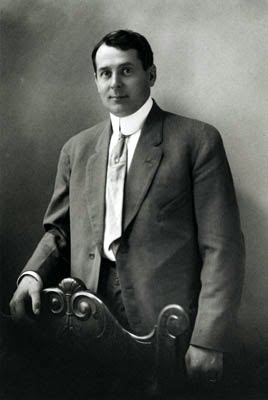Harry Wardman

Harry Wardman (April 11, 1872 – March 18, 1938) was a real estate developer in Washington, D.C. during the early 20th century whose developments included landmark hotels, luxury apartment buildings, and many rowhouses. When he died in 1938, one-tenth of the residents of Washington were said to live in a Wardman-built home.[1]
Personal life[edit]
Born in Bradford, England in 1872 (the 1900 federal census - Washington, D.C. - says he was born April 1869), Wardman was the son of English textile workers. In 1889, at age 17, he arrived in New York City, where he worked in a department store. He later moved to Philadelphia, where he worked at the Wanamaker's department store and met his wife, Mary Hudson. They had one daughter, Alice. In 1898, he apprenticed himself to a local carpenter to learn construction.[1] By 1900, Wardman was widowed. In 1902, Wardman moved to Washington, D.C., where he worked as a carpenter, learned to build staircases, and soon got into building homes and apartments. In 1908, he married Lillian Glascox. Harry and Lillian had one daughter, Helen.
Building career[edit]
Rowhouses[edit]
The first independent project Wardman embarked upon was a six-house ensemble in Sixteenth Street Heights, on Longfellow Street, in 1898; while the term did not exist yet, these were what would later be termed "rowhouses".[2] The success of the Longfellow Street project pushed Wardman to scale this model up in Columbia Heights, in 1907, wherein he built blocks of rowhouses branching east and west off of Fourteenth Street, between Monroe Street and Spring Street.[2] These 750 rowhouses included new design elements, most notably the front porch. Wardman built many of the city's rowhouses, especially in the neighborhoods of Columbia Heights, Bloomingdale, Eckington and Fort Stevens Ridge. To this day, his homes are renowned for their high-quality construction and materials. Some of his design ideas were copied by the dozens of other developers — Lewis Brueninger, Harry Kite, Francis Blundon, David Dunigan, and others — who built massive rows of townhouses in the District.
Apartments[edit]


Wardman's success at rowhouses allowed him to move up to building luxury apartment buildings, mostly designed by architect Albert H. Beers and Frank Russell White, and located along 16th Street, NW, Connecticut Avenue, Columbia Heights, and elsewhere. They include:
- Northbrook Court - 3420/3426 16th Street, NW
- The Chastleton - 1701 16th Street, NW
- Somerset House - 1801 16th Street, NW
- The Wardman - 1916 17th Street, NW
- The Melwood - 1803 Biltmore Street, NW
- The Brittany - 2001 16th Street, NW
- The Dresden - 2126 Connecticut Avenue, NW
- The Maxwell - 1419 Clifton Street, NW
- The Nelson - 1733 20th Street, NW
- Chatham Courts - 1707 Columbia Road, NW
- Northumberland Apartments - 2039 New Hampshire Avenue, NW
- Rutland Court - 1725 17th Street, NW
- South Cathedral Mansions - 2900 Connecticut Avenue, NW
- Wardman Court (formerly, Clifton Terrace) - 1312 Clifton Street, NW
- Wardman Row - 1416-1440 R Street, NW
- Copley Plaza - 1514 17th Street, NW
- Cavanaugh Court - 1526 17th Street, NW
- Apartment Building at 2225 N Street
- The Brighton - 2123 California Street, NW
- The Claiborne - 3033 16th Street NW
Hotels[edit]

In 1918, he opened the 1,200-room Wardman Park Hotel along Connecticut Avenue in Woodley Park. The hotel was successful, meeting the strong demand of an influx of government workers after World War I. It was expanded in 1928 with the Wardman Tower, an adjoining apartment building. The hotel was sold to Sheraton Hotels in 1953, becoming the Sheraton-Park Hotel. The main building was demolished in 1977 and replaced with a modern hotel, the Sheraton Washington Hotel. The Wardman Tower was saved and was added to the National Register of Historic Places in 1984.[3] The 1977 Sheraton Washington Hotel has since been renamed the Marriott Wardman Park, in honor of Wardman's original building.
In 1926 he built The Carlton Hotel, designed by Armenian-American architect Mihran Mesrobian and today known as The St. Regis Washington, D.C.
In 1928, Wardman built the Hay-Adams Hotel, also designed by Mesrobian and located across from Lafayette Park. Other landmarks built by Wardman include the British Embassy.
Wardman's efforts made him wealthy, and for a time he lived extravagantly in Washington and abroad. But most of his $30 million fortune vanished in the 1929 stock market crash. He continued to build middle-class homes. Wardman died in 1938 from cancer and is buried in Rock Creek Cemetery.
Suburban developments[edit]
In 1927, he assumed the presidency of Washington Suburban Realty Company, developer of Cheverly, Maryland. He held that position until the stock market crash of 1929.[4]
References[edit]
- ^ a b https://npgallery.nps.gov/NRHP/GetAsset/NRHP/84000869_text
- ^ a b "Wardman's World - The Washington Post". Archived from the original on 2020-06-28.
- ^ Description of listing of Wardman Park Annex and Arcade (Wardman Tower and Arcade) on National Register of Historic Places in website of National Register of Historic Places.com. Accessed September 9, 2009.
- ^ "Community Summary Sheet, Prince George's County" (PDF). Cheverly, Maryland. Maryland State Highway Administration, 1999. 2008-05-10.
Further reading[edit]
- Berk, Sally (2004) "Wardman Row House Tour", D.C. Preservation Advocate. Spring 2004 newsletter. [1]
- Fleishman, Sandra (October 15, 2005) "Wardman's World", The Washington Post. p F01. [2]
- Kelsey & Associates, Inc. (Paul K. Williams). History of the Hay-Adams Hotel. Manuscript, 2000.
- Toomey, Helen, Faith Hofstader (1998) Harry and Lillian Wardman Papers, 1916-1930, Special Collections Finding Aid. The Historical Society of Washington, D.C.
- Washington Post (March 19, 1938) "Wardman Dies: Made and Lost Riches in Realty Englishman Who Became D.C. Building Leader Was 65. Wardman Dies Made and Lost Riches in Realty Wardman", The Washington Post. p. X1.
- Williams, Paul K. 'Harry Wardman,' section included in various house histories, 1995-2006.
External links[edit]
 Media related to Harry Wardman at Wikimedia Commons
Media related to Harry Wardman at Wikimedia Commons
